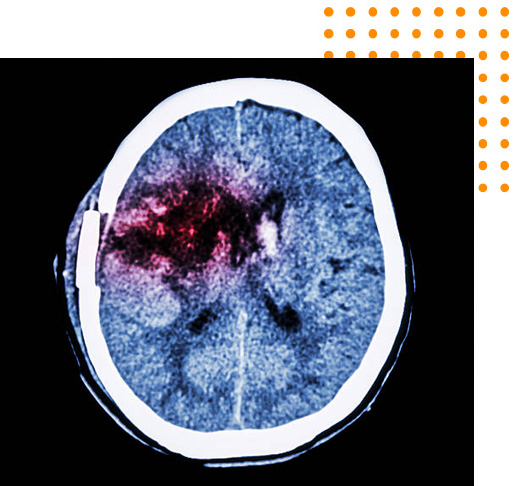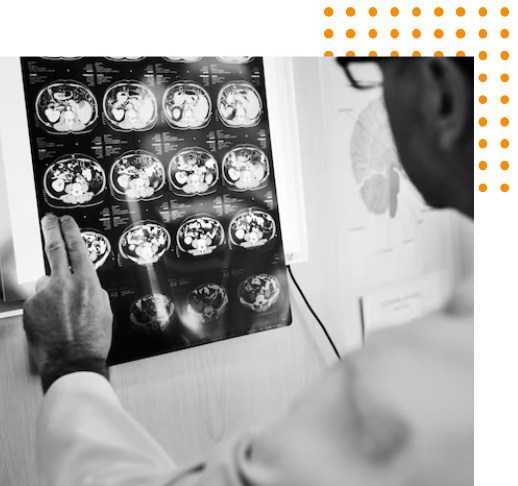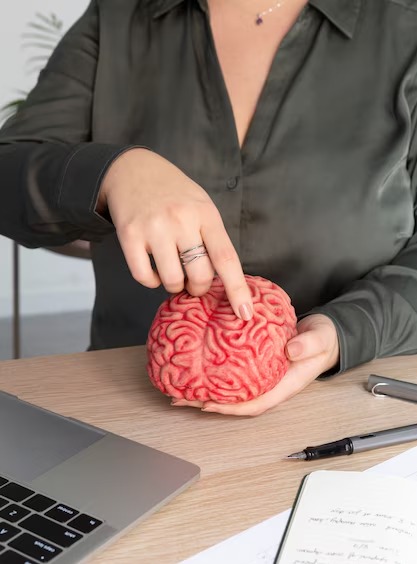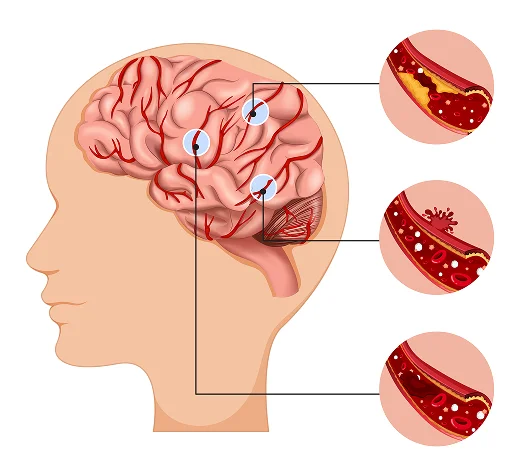Cerebral Stroke
Home > Treatments > Cerebral Stroke
Cerebral Stroke Doctor in Kolkata
A cerebral stroke is a medical emergency that occurs when blood flow to the brain is interrupted, leading to brain cell damage or death. In some cases, surgical intervention is required to alleviate pressure, repair damaged blood vessels, or remove clots. One such life-saving surgery is a craniotomy, a procedure in which part of the skull is temporarily removed to access the brain. For patients in critical conditions, especially those suffering from hemorrhagic or ischemic strokes, a craniotomy can be essential to prevent further brain damage and enhance recovery. In Kolkata, Dr Rohit Mishra, an experienced cerebral stroke doctor, and craniotomy neurosurgeon plays a pivotal role in providing this advanced treatment.
What is Craniotomy for Cerebral Stroke?
A craniotomy for cerebral stroke involves surgically removing a portion of the skull to gain access to the brain. This procedure is typically performed by a specialized craniotomy neurosurgeon in cases where a stroke has caused significant bleeding, clot formation, or brain swelling. Once the brain is accessed, the surgeon can remove blood clots, repair damaged blood vessels, or relieve pressure caused by excess fluid or swelling. After the procedure, the removed portion of the skull is replaced.
This surgery is often performed as an emergency procedure to save the patient’s life or prevent severe disability. Cerebral strokes can be ischemic (caused by a blocked artery) or hemorrhagic (caused by a ruptured blood vessel). Both types can lead to critical conditions requiring immediate surgical intervention.
Contact Dr. Rohit Mishra, the best neurosurgeon in Kolkata, for cerebral stroke treatment.


Types of Cerebral Stroke That Require Craniotomy
A cerebral stroke can result from various causes, and a craniotomy may be necessary depending on the severity and nature of the stroke. Some common conditions that may lead to the need for a craniotomy include:
Intracerebral Hemorrhage
When a blood vessel in the brain bursts, causing bleeding within the brain tissue, it can lead to severe damage. A craniotomy procedure allows the surgeon to remove the accumulated blood, relieving pressure on the brain and preventing further harm.
Subarachnoid Hemorrhage
This condition occurs when there is bleeding in the space around the brain, often due to a ruptured aneurysm. Without timely intervention, the pressure can build up rapidly, leading to severe brain damage. A craniotomy can help relieve this pressure and repair the damaged vessel.
Cerebral Ischemic Stroke
An ischemic stroke occurs when a blood clot blocks an artery supplying blood to the brain, causing tissue damage. While many ischemic strokes are treated with medications or clot-busting drugs, severe cases may require surgical removal of the clot through a craniotomy to restore blood flow.
Brain Swelling
Cerebral infarction or ischemia can cause the brain to swell due to inflammation or fluid buildup. A craniotomy allows the surgeon to relieve this pressure, preventing further complications such as permanent brain damage.
Why a Craniotomy is Necessary for Stroke Patients?
A stroke can cause life-threatening complications, such as brain swelling, hemorrhage, or blood clot formation. For patients facing these challenges, a craniotomy can:
- Relieve Pressure on the Brain: Swelling or fluid buildup after a stroke can lead to increased intracranial pressure, which may cause further damage to brain tissue. A craniotomy helps alleviate this pressure.
- Repair Damaged Blood Vessels: In cases of hemorrhagic stroke, a craniotomy allows the surgeon to stop the bleeding by repairing ruptured blood vessels.
- Remove Blood clots: Blood clots can block important blood flow in the brain, leading to an ischemic stroke. A craniotomy helps surgeons access and remove these clots.
- Save lives: In many instances, a craniotomy is the only option to prevent severe neurological damage or death following a cerebral stroke.

Book an appointment today

Craniotomy Procedure for Cerebral Stroke
The craniotomy procedure is performed under general anesthesia. Here’s a step-by-step overview of what happens during the surgery:
- Preparation: The patient is placed under anesthesia, and the surgeon marks the area of the skull where the incision will be made.
- Incision: A small section of the scalp is shaved, and an incision is made to expose the skull.
- Bone Removal: The surgeon carefully removes a portion of the skull to access the brain. This piece of bone is set aside and will be replaced after the procedure.
- Brain access: The neurosurgeon works on the affected area of the brain to remove clots, relieve pressure, or repair damaged blood vessels.
- Closure: After the necessary work is done, the piece of the skull is replaced and secured with plates or screws. The scalp is then sutured back in place.
- Post-surgery care: The patient is closely monitored for any complications, and post-operative care is essential for recovery.
What to Know Before Getting a Craniotomy for Cerebral Stroke
- Risks and Benefits: Like all surgeries, craniotomy comes with risks. These may include bleeding, infection, or injury to surrounding brain tissue. However, the potential benefits often outweigh the risks, especially when the surgery is performed to prevent life-threatening complications of a stroke.
- Preparation: Patients will need to follow pre-operative instructions provided by their cerebral stroke doctor in Kolkata, which may include fasting, stopping certain medications, and undergoing diagnostic tests.
- Post-operative Care and Recovery: After the procedure, patients typically need close monitoring and may require physical therapy, speech therapy, or occupational therapy to regain their abilities. The recovery process depends on the severity of the stroke and the success of the surgery.
- Long-term Prognosis: The outcome of the surgery depends on several factors, including the type of stroke, the extent of brain damage, and the patient’s overall health. Patients will need regular follow-up visits with the craniotomy doctor in Kolkata to monitor their progress and discuss any necessary lifestyle changes or medications.


Why Choose a Craniotomy Neurosurgeon in Kolkata?
Finding the right craniotomy neurosurgeon in Kolkata is crucial for achieving the best possible outcome. An experienced neurosurgeon, like Dr. Rohit Mishra, can ensure the procedure is performed with precision, leading to a better chance of recovery and a higher quality of life. If you or a loved one is facing the aftermath of a stroke, consult him to understand the available treatment options and whether a craniotomy is necessary.
A craniotomy for cerebral stroke is a critical procedure that can save lives and improve outcomes for patients facing life-threatening complications from a stroke. Understanding the procedure, its benefits, and the recovery process is essential for making informed decisions about your health. For expert care and the best treatment options, seek out a cerebral stroke doctor in Kolkata or consult with a craniotomy neurosurgeon to get the help you need.
Frequently Asked Questions
What is a craniotomy for cerebral stroke?
A craniotomy for cerebral stroke is a surgical procedure performed to relieve pressure on the brain caused by swelling or bleeding after a stroke. It involves temporarily removing a part of the skull to allow the brain to swell without causing further damage.
When is a craniotomy necessary after a stroke?
A craniotomy is typically required when a stroke leads to significant brain swelling or bleeding that threatens critical brain functions. It is considered a life-saving procedure for patients who do not respond to other treatments or whose condition rapidly deteriorates.
What are the risks of a craniotomy for stroke?
Risks associated with a craniotomy for stroke include infection, bleeding, seizures, and neurological complications. While it carries these risks, the procedure is often necessary to prevent severe brain damage or death due to pressure build-up from swelling.
What is the recovery process like after a craniotomy for a stroke?
Recovery from a craniotomy after a stroke can be gradual and requires intensive rehabilitation, including physical therapy, speech therapy, and cognitive rehabilitation. Recovery times vary depending on the severity of the stroke and the patient’s overall health, and close medical monitoring is essential.
Can craniotomy improve stroke outcomes?
In certain cases, a craniotomy can improve stroke outcomes by reducing brain swelling and preventing further brain injury. While it does not reverse stroke damage, it can help stabilize the patient and increase the chances of recovery through rehabilitation.
